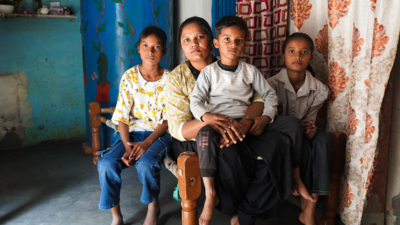- News
- City News
- meerut News
- Justice on hold: Thousands await as delay in viscera reports derailing investigations & court cases
Trending
Justice on hold: Thousands await as delay in viscera reports derailing investigations & court cases
Thousands of families are left waiting indefinitely for justice, closure, and compensation as viscera reports remain pending in forensic labs. Bureaucratic inefficiency, mismanagement, and systemic flaws within the forensic process further delay investigations, hindering court hearings and justice delivery.
Thousands of families wait for justice, closure and compensation with viscera reports pending, often indefinitely, in forensic labs. What causes the delay and what is the way out? TOI investigates
The words have become a stock phrase trotted out by law enforcement authorities. “We have preserved the victim’s viscera for further investigation.” Or, “The viscera report is awaited before we can come to any conclusion.” But even as they are routinely uttered at press briefings, for thousands of families they represent justice delayed or an endless wait for closure and compensation. Komal Kashyap, 31 now and a mother of three, knows this all too well.

She has spent the last four years in suspended grief. Every three months, she walks into Jani police station in Meerut, hoping for an answer that never comes. Her husband, 30-year-old Sachin Kashyap, a pulp operator at a paper mill in the city’s Partapur region, died under unclear circumstances in 2021. The cause of death remains unknown, locked inside a viscera report that has yet to arrive. In Ganganagar, Karan Chaudhary, 62, is trapped in a different kind of limbo. His 21-year-old son Ritik was found dead in a hotel room last year.

“The police tell us to wait. But how long? A year? Two? Five? All we are left with are theories, none of them confirmed,” she says. These families are among thousands caught in judicial purgatory. According to data accessed by TOI from the office of additional director general (ADG), UP Police Technical Services, more than 15,000 viscera reports are pending across forensic labs in the state. Cases involving VIPs, court reprimands, and law-and-order concerns take priority. For everyone else, justice is deferred — perhaps indefinitely.
For the bereaved, the delay is more than a technical lapse. It is an obstruction of justice. Without viscera reports, courts hearings stall, investigations stagnate, and suspects almost always walk free. Ask Ritik’s father, who sees it firsthand. “Police are slow in acting against the accused. Every time, they say they need the report to confirm poisoning. Meanwhile, we remain under constant threat from those who killed our son,” he says.

For Komal, the repercussions extend beyond grief. Her widow’s pension — Rs 7,000 a month — is frozen under the Employee’s State Insurance Scheme (ESIC) because her husband’s cause of death remains unverified. “Forget the pension,” she says bitterly. “Don’t I at least have the right to know how he died?” The problem runs deeper than simple bureaucratic inefficiency. The forensic system itself is fractured, a network of mismanaged samples, outdated processes, and blame-shifting. Dr Praveen Dixit, former senior resident at the department of forensic medicine and toxicology, AIIMS-Raebareli, explains the science behind the failure.
“After a post-mortem, viscera should be stored at 4°C under a maintained cold chain. But in practice, we hand it over to the police, who transport it in open vehicles, exposing it to fluctuating temperatures. The samples then end up in the police maal khana (storage room), which is not air-conditioned. Ideally, they should be in deep freezers, but such facilities are rare.” From there, samples travel — again in non-refrigerated police vehicles — to the State Forensic Science Laboratory (SFSL), where they sit for months.
The longer they wait, the more they decompose. The result is often unreliable reports, sometimes useless in court. The problem is not just storage but also the sample size. Standard guidelines require adequate weight for each category. For instance, an entire kidney or at least 20 grams of liver for toxicology testing. “But we often receive just 5 grams,” a forensic analyst admits. “That’s barely enough for analysis, increasing the chance of a negative viscera test.” Police officers, however, say the problem starts with medical officers, who overburden forensic labs with unnecessary cases. “It has become routine,” says a senior officer, requesting anonymity.
“Even in clear-cut accident cases, viscera is preserved when it’s not needed, just to shift the responsibility elsewhere. Imagine dozens of organ samples being transported every day, over 50-60 km, in non-refrigerated boxes. No wonder maal khanas reek of decay.” Yet, when the evidence does reach the courtroom, it often holds the key to cracking a case and conviction. A compromised report can mean an acquittal. SFA Naqvi, a senior criminal lawyer at Allahabad HC, explains the stakes. “A crime is proven with corroborative evidence, and the viscera report is one of the most important in the court of law. If this evidence is delayed, tampered with, or mishandled, the accused benefits. There have even been cases where investigating officers claim the viscera was ‘lost’ — for reasons only they know.”
The backlog of reports is not just an administrative inconvenience. It is a systemic collapse. In Nov 2021, Allahabad HC directed the Uttar Pradesh DGP and the home secretary to expedite forensic testing, stating, “There is no established method for the swift analysis of viscera, delaying investigations indefinitely.” Authorities claim they are working to fix the problem. “Before 2017, UP had only four FSLs,” says Naveen Arora, ADG, UP Police Technical Services. “We have since established eight more, with six additional ones under construction. Once completed, every state range will have an FSL. However, toxicology divisions — where viscera is examined — are currently operational in only nine labs (Lucknow, Agra, Moradabad, Ghaziabad, Jhansi, Prayagraj, Varanasi, Gorakhpur, and Kannauj), with three more planned in Bareilly, Aligarh, and Gonda.” The numbers tell a different story.
Of the 1,157 sanctioned technical positions in UP’s FSLs, sources say over 60% remain vacant. Without forensic analysts, the new labs are little more than buildings with locked doors. Hiring falls under the jurisdiction of the UP govt, the Uttar Pradesh Public Service Commission (UPPSC), and the Uttar Pradesh Subordinate Service Selection Commission (UPSSSC). Officials claim the recruitment process is “ongoing,” but there is little clarity on when it will be completed. Arora acknowledges that the entire forensic ecosystem needs synchronised coordination. “Several factors contribute to the backlog, including flaws in viscera collection, improper handling by medical officers, the casual approach of investigating officers (IOs), and incomplete data.
In toxicology tests, nearly all types of poisons must be tested sequentially, often requiring retesting, which extends the process. We are working on multiple solutions—continuous training for IOs and FSL staff, redistributing toxicology cases to less burdened labs, procuring modern analytical equipment, and expanding toxicology divisions within FSLs.”
For families like Alisha Rizvi’s, these promises mean little as of now. “I do not nurture malice against anyone in the system for this indifference,” she says. “But the innumerable theories that crop up about how he died continue to haunt us.”

About the Author
Sandeep RaiEnd of Article
FOLLOW US ON SOCIAL MEDIA







